Teaching as a Team Sport Transcript
+++ 00:00:00 +++
Emily Tannenbaum: Not only are you in charge of your learning, you're in charge of your partner's learning and your group.
Ron Chaluisan: The notion of deeper learning is about figuring out which pieces make sense and constructing an argument and then being able to publically state it and defend it.
Chris: Without that chart that's above it, you wouldn't be able to tell which bar goes to which interval.
Xiomara Gonzalez: Today we're going to look at target student work for Anna's class.
+++ 00:00:33 +++
Xiomara Gonzalez: Teaching should never be done alone. You need the support of others because it's impossible to do your job well by yourself.
Xiomara Gonzalez: One way to support Chris might also be just to have him look at another student. Letting him use that flexibility.
Russell West: It's sort of teaching as a team sport.
Anna Tabor: Whatever makes the most sense to you because you're the one that's going to have to interpret the data.
Katelyn: Math is a really cool subject. We do like everyday life with our math.
Anna Tabor: The kids really understand at a deeper level what they're doing because we're spending more time letting them get to that deeper level.
+++ 00:01:02 +++
Anna Tabor: You guys may begin.
Card:
Deeper Learning: New Visions
Lower Third:
Bronx Latin School
Bronx, New York
Card:
Teaching as a Team Sport
+++ 00:01:18 +++
Emily Tannenbaum: You're going to need your math notebook out and you're going to need a pen or a pencil, whatever you're used to using.
Lower Third:
Russell West
Lead Instructional Coach
New Visions for Public Schools
Russell West: New Visions for Public Schools is an organization that is supporting New York City Public High Schools.
Anna Tabor: What does this represent? This whole axis?
Russell West: We work with math teachers in those schools to enact a new project. Accessing Algebra Through Inquiry, how math instruction takes place aligned with the new Common Core Learning Standards.
+++ 00:01:48 +++
Student: The Nicks have a higher, frequent percentage than the Pacers then that means that that requires more baskets and more points.
Student: Yeah.
Russell West: The first place to look for why this project makes better students and encourages deeper learning is to really read the standards for mathematical practice that are part of the common core.
Lower Third:
9th Grade Integrated Algebra
+++ 00:02:08 +++
Emily Tannenbaum: It's your responsibility to ask questions to yourself, ask questions with your partner and so not only are you in charge of your learning, you're in charge of your partner's learning and your group.
Lower Third:
Emily Tannenbaum
9th Grade Math Teacher
Bronx Latin, Bronx New York
Emily Tannenbaum: My name is Emily Tannenbaum. I teach integrated algebra at Bronx Latin.
Emily Tannenbaum: I want to warn you I will not be giving you answers today and I know that you like asking me questions and having me give you an answer so don't be frustrated.
Emily Tannenbaum: You remember things that you have emotional connections to. That's pretty much what Accessing Algebra Through Inquiry is is being curious to find an answer so you can create this emotional connection.
+++ 00:02:43 +++
Destiny: How many combinations it had to get to seven?
Emily Tannenbaum: So you're saying that's not a random game?
Chris: There are less chances. It's like favorable.
Destiny: Yeah.
Chris: For seven. It's like biased.
Emily Tannenbaum: It's biased. Okay, alright.
Lower Third:
Destiny
9th Grade Student
Bronx Latin, Bronx New York
Destiny: It's a lot different. In my old school the teacher would just like dictate work to you and then you just do it and learn it, I guess. But in algebra now it's different because you have to think for yourself.
Emily Tannenbaum: So let's say you had a bag with letters of the alphabet in it, like all in it.
+++ 00:03:14 +++
Student: You can't randomly choose like well I think it's false.
Student: You're just picking out random letters so you can get anything.
Lower Third:
Ron Chaluisan
Vice President
New Visions for Public Schools
Ron Chaluisan: We are striving to understand deeply how secondary school students learn, and then help the adults who are charged with that become better at creating opportunities that support students in their learning.
Emily Tannenbaum: How many ways could horse three?
Student: Two.
Emily Tannenbaum: Two ways. So if I had to say what's the probability of horse three winning the race, what would your answer be?
+++ 00:03:44 +++
Student: Two.
Student: Two out of-
Student: Two out of thirty-six?
Emily Tannenbaum: I know I'm a new teacher but the transition hasn't been so hard because with this new program there is so much collaboration, it's pretty amazing.
Lower Third:
Teacher Inquiry Session
Xiomara Gonzalez: So today we are going to look at target student work for Anna's class.
Lower Third:
Xiomara Gonzalez
Math Coach
New Visions for Public Schools
Xiomara Gonzalez: We uphold inquiry as one of our pillars looking at student work and making decisions as a team and leveraging the wisdom of crowds.
+++ 00:04:13 +++
Xiomara Gonzalez: We're going to support her in figuring out what they can and cannot do.
Xiomara Gonzalez: I serve as a math coach and work with teachers one-on-one in their classrooms, outside of their classrooms, and also support team meetings focused on looking at student work and making evidence-based decisions.
Xiomara Gonzalez: We're going to give Anna three minutes to kind of provide context for the work we are looking at and talk about target students Natalie and Chris.
Anna Tabor: So I'm going to give everyone this is their homework from last night actually.
Lower Third:
Anna Tabor
8th Grade Math Teacher
Bronx Latin, Bronx New York
+++ 00:04:42 +++
Anna Tabor: At first I was very hesitant because I've been teaching the same way and I've had good results and I've done the same thing for five years. And it was different during the summer. We sat down. We had professional development, and it was actually nice to sit in a room full of people saying "Let's take a step back. Let's slow this down. Let's get more in depth."
Anna Tabor: So this is just whether or not they are able to create appropriate histograms and all the requirements of what that should be.
+++ 00:05:07 +++
Ron Chaluisan: Bringing teachers together in these inquiry groups, really putting student work on the table, not pulling them away from their content area. Actually pushing them deeper into their content area in order to understand what the work says to them, and then having public conversations about that has changed the dynamic in schools.
Anna Tabor: So we actually just had a lesson yesterday on creating histograms. I only really did one example problem with them. They seemed to know pretty well what a histogram is.
+++ 00:05:37 +++
Xiomara Gonzalez: Each teacher has their own two target students that we've been looking at throughout the course of the whole year.
Anna Tabor: Chris did a really good job of interpreting his data, life expectancy in the Middle East and so Chris was able to interpret the highest frequency life expectancy was lower than the United States and so they were talking about what does that mean? Why is that?
Lower Third:
Chris
8th Grade Student
Bronx Latin, Bronx New York
Chris: She's taught me a lot and she's made me a little more confident of like asking questions letting you know, she helps with my confidence and stuff and I'm doing pretty good in math.
Anna Tabor: So Natalie had a really hard time interpreting what the frequencies meant if there's more frequencies in certain ranges or intervals she had a really hard time articulating what did that mean, how to interpret that.
+++ 00:06:13 +++
Russell West: The theory behind the inquiry team is that one person can do a whole lot, but a team of people could do a whole lot more to understand how students are learning.
Anna Tabor: I would want him to be able to look at this and say the highest frequency was from 50 to 59. That's not good.
Russell West: It's sort of teaching as a team sport.
Xiomara Gonzalez: One way to support Chris might also be just to have him look at another student, letting him use that flexibility and seeing how another student did it.
+++ 00:06:38 +++
Xiomara Gonzalez: Teaching should never be done alone. And the reason you need support of others because it's impossible to do your job well by yourself. You need a place to reflect. You need a place to share what you're doing and justify why you're doing it.
Xiomara Gonzalez: Anna, you get the last word, it's the last minute of take-aways.
Anna Tabor: For me this just means that for today's activity I really need to make sure that I actually go through and highlight scales and interval and labeling, that they still need help with a little bit of the basic stuff.
+++ 00:07:09 +++
Xiomara Gonzalez: We have math practices that we want students to engage in and they are the same for teachers. It's like teacher needs to be able to justify their reasoning and critique the reasoning of others and make sense of a problem and persevere in solving it, understand how what they are teaching is supporting their students beyond the classroom and why it's so important when these kids leave.
Lower Third:
8th Grade AP Algebra
+++ 00:07:31 +++
Anna Tabor: Can someone tell me this is actually I think this is kind of a misleading graph and you haven't seen completely why it's misleading yet but can someone give me some reasons as to why this is actually hard to make good comparisons? Vivien?
Vivien: Probably because the Y axis is not labeled so you don't know what it represents.
Anna Tabor: Okay yeah, you're saying this axis is completely missing labels. You don't know what it represents.
+++ 00:07:52 +++
Xiomara Gonzalez: Anna used her plan and she immediately started by showing student work for Natalie and Chris and used the advice that we had given during the team meeting.
Anna Tabor: So we're going to look at Natalie's first two histograms. Let's start off on what did Natalie do right on these histograms, Vivien?
Vivien: Her bar graphs are not separated so that's good.
Anna Tabor: Okay they're not separated. They are touching. Histograms are supposed to touch. Can anyone tell me some things that are missing?
Student: She didn't put a title on the top of her graph.
+++ 00:08:23 +++
Anna Tabor: Okay she didn't put titles on top of her graph. What else about this is a little bit off? Katelyn?
Katelyn: I see intervals but then maybe it's the way she did it. It doesn't look like there's bars above it?
Anna Tabor: Yeah.
Lower Third:
Katelyn
8th Grade Student
Bronx Latin, Bronx New York
+++ 00:08:35 +++
Katelyn: I've always really liked math and she's gotten me to a point where math is like a really cool subject and like the way she also teachers we do like everyday life with our math. We're more involved and we can understand it more and it makes it a lot simpler to think about it.
Anna Tabor: Let's look at Chris' graph. You actually have all the bars for all the data but it doesn't match your intervals, so why is that?
Chris: Well because after I labeled X and Y I wrote the numbers on X and Y axis then I really I wasn't really 100 percent focused on where I put them. I just drew the bars.
+++ 00:09:11 +++
Chris: In this school you are always encouraged to participate. Yeah I think that's good because we all need to participate because part of it is because it's part of our grade. Second of all it gives us a chance to give our thoughts and then maybe help someone who didn't know in the first place.
Anna Tabor: Here you actually made the bars a little bit wider. Do you think you could have done that here too? Yeah.
Xiomara Gonzalez: And she gave Chris the opportunity and Natalie the opportunity to reflect on their work publically which is really hard.
Chris: The bars aren't where they're supposed to be so I thought that the chart that's above it, you wouldn't be able to tell which bar goes to which interval.
+++ 00:09:45 +++
Anna Tabor: I'm teaching them math but I'm really teaching them perseverance, how to work through problems when they get difficult. I'm teaching them working in groups which is something that they're going to have to do in real life.
Anna Tabor: Whatever makes the most sense to you because you're the one that's going to have to interpret the data.
+++ 00:10:04 +++
Ron Chaluisan: The notion of deeper learning is about figuring out which pieces make sense and constructing and argument, and then when you construct that argument being able to publically state it and defend it.
Chris: Based on the information shown in each graph I think the Nicks are better with the rebounds than the Pacers.
+++ 00:10:25 +++
Anna Tabor: I mean it's changed me as a teacher. It's made me a lot more thoughtful and deliberate. Being able to work with other teachers, bounce off other ideas, it's just really helped me figure out how to actually get more in depth. The kids really understand at a deeper level what they're doing because we're spending more time letting them get to that deeper level so I hope that they just look back on it and say "This is what learning should be."
#### End of newvisions_main

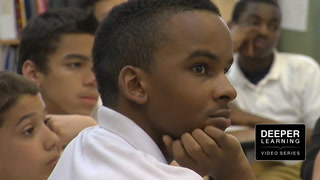
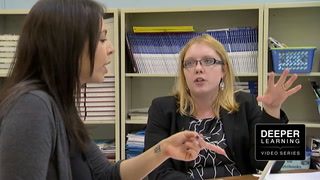
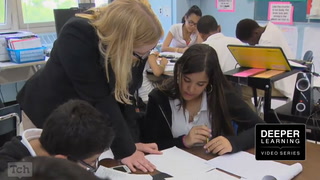
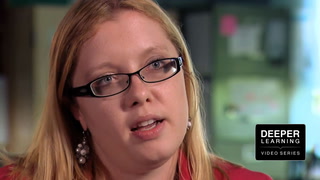
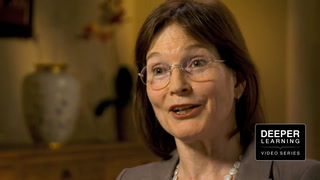








5 Comments
Elizabeth Owonikoko Jul 7, 2020 5:27pm
Teaching is really a team sport and so should not be done in isolation. I can see the Math teachers collaborating, sharing ideas, and ways to make their teaching better and more engaging by bringing students' worksheets to their meeting and using them as their means of effective collaboration. This video also teaches that as a teacher, your struggles can be shared with other colleagues to get better solutions. Having the students critique their own work in front of the class gives the class a better understanding of what can be done differently next time and encourage participation.
Lynn Lemieux May 11, 2014 12:09pm
austine etcheverry May 9, 2014 3:48pm
Kimberly Fernandez May 9, 2014 3:34pm
Monica Sandoval Apr 11, 2014 11:20am